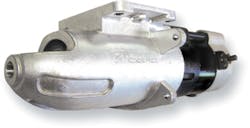So your customer is buying a new starter for their aircraft and asking for a recommendation. You agree to do some research. It would be easy to become overwhelmed by the myriad of starter choices currently available. Aircraft starter manufacturers have developed a variety of high-performance, lightweight starters suitable for use in most installations. When it comes to selecting a new starter, what should a buyer take into consideration? Taking the time to evaluate a few fundamental factors will help ensure that your recommendation will be sound.
Assuming the starters in question are all FAA approved, several criteria must be considered when making a starter selection. Among the most rudimentary would be physical fit, that is, can the starter being considered be installed in your customer’s aircraft without significant airframe modifications. Weight is another factor that many buyers will consider. After all, in the world of aviation lighter is usually better and the starter’s installed location in the aircraft makes weight a worthy consideration. Starter manufacturers publish information on their products regarding fit and weight so these factors are usually easy to assess.
After reviewing the prospective new starter’s fit and weight it’s time to get into the nitty-gritty of starter assessment, its performance. Performance is the most important aspect to evaluating a new starter. The important key measurements in assessing a starter’s performance are engine cranking speed (crank shaft rpm), electric current draw (amps), and operational duty cycle.
Cranking speed
First, give consideration to the starter’s rated cranking speed. This parameter measures the speed at which the starter rotates the engine’s crankshaft during a start. You may think that a higher cranking speed would be better but this is not always the case. The starter is part of the engine’s starting system which also includes the fuel and ignition systems. These systems have been designed to provide good starting characteristics for a particular starting speed range. For most engines this speed is between 120 and 180 rpm. Cranking the engine faster than 200 rpm may disengage the magneto impulse couplings thereby advancing the ignition timing which will result in poor engine starting and can even induce kickbacks! Choose a starter which will not exceed the engine manufacturer’s recommended cranking speed. If this information is not available, a good approach would be to select a starter that cranks your engine at the same or similar speeds as the starter originally supplied by the engine OEM.
Current draw
Next, consider the starter’s current draw as this characteristic directly affects the amount of heat that builds up in the starter when cranking the engine. The more current the starter pulls, the more heat that is generated in the starter. Increased heat reduces cranking performance, shortens the overall life of the starter, and drains the battery. The rate of temperature increase also decreases the duty cycle of the starter which means fewer starts before the starter reaches its temperature limit. Overheating is the leading cause of premature starter failure as high temperatures have a debilitating effect on all starter components, particularly brushes and bearings.
Current draw also affects other components in the aircraft starter electrical system. Contactors, terminals, and cables are all adversely affected by high current draw. Current draw is particularly important to pilots who have the battery located in the rear of the aircraft. The cable between the battery and the starter acts as a resistor which causes a voltage drop over its length. This voltage drop increases in direct proportion to increases in current. The resulting electrical power lost to heat over the length of the cable is not available for use by the starter. Higher current draw results in greater voltage drop and less power to the starter.
Current draw also determines the number of starts you will get from the battery. For a given charge condition, the battery is capable of delivering a given number of starts and that number is directly related to the amount of current the starter draws while cranking. A starter drawing twice the current will only give you half the number of starts before battery depletion.
Operational duty cycle
A final performance factor that should be considered is the starter’s operational duty cycle. This characteristic is important as it reflects how well the starter can tolerate repeated starting attempts and overcranking abuse. Duty cycle is a ratio that measures how long a device may be operated to how long it must rest. This ratio is usually represented as a percentage of operational time to rest time. In the case of a starter it reflects how long you can engage the starter and how long you must allow the starter to rest before the next starter engagement. Most starters on the market today have duty cycle ratings of around 4 to 6 percent, but some can exceed 10 percent duty cycle ratings.
So why is duty cycle so important? Warranty data from starter manufacturers indicates that the principle cause of in-service starter motor failures is overcranking abuse. A starter with a higher duty cycle will be able to deliver a higher number of starts within a given window of time without overheating. This is an important performance indicator when considering a starter as it will have a direct impact on starter longevity.
Fit, weight, performance, and any additional features available are all considerations you should keep in mind when evaluating aircraft starters. The tips in this article should help you make a more educated purchasing decision the next time you consider a replacement starter.
Rick Quave is director of engineering at Kelly Aerospace Power Systems, makers of E-drive starters. Rick can be reached at [email protected].





